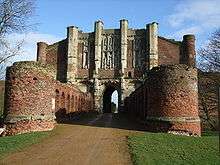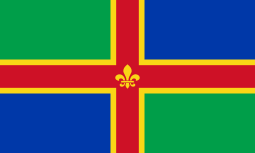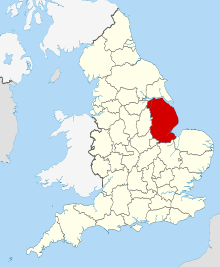Thornton Abbey
Thornton Abbey was a medieval abbey located close to the small North Lincolnshire village of Thornton Curtis, near Ulceby.

It was founded as a priory in 1139 by William le Gros, the Earl of Yorkshire, and raised to the status of abbey in 1148. It was a house for Augustinian or black canons, who lived a communal life under the Rule of St Augustine but also undertook pastoral duties outside of the Abbey. Officers within the abbey included a cellarer, bursar, chamberlain, sacrist, kitchener and an infirmer.
The abbey was closed in 1539 by Henry VIII as part of the Dissolution of the Monasteries. Thornton was a wealthy and prestigious house valued at the dissolution at the considerable sum of £591 0s 2¾d. It managed to survive by becoming a secular college, until it was closed in 1547.
Thornton Abbey railway station is nearby.
Architecture


The founding abbey building from the 12th century was Romanesque in style, but nothing of it remains above ground.
The later abbey from the 13th/14th centuries was built in Early Gothic style. Little remains of the building, except for three walls of the chapter house and part of the cloister, though the ground plan of the abbey is traced out.
The main interest lies in the gatehouse which is amongst the earliest large-scale uses of brick in England. It stands two storeys high and is structurally intact. There are few windows in the building, and the internal dimensions are cramped due to the thickness of the walls.
The outside of the building is adorned with three almost life-size statues directly above the gate. A bridge over the moat adjoins the gatehouse and is fortified with walls and guardrobes.
Later history
Since the dissolution the site has been owned by: Henry Randes (the Bishop of Lincoln); Sir Robert Tyrwhitt of Kettleby; Sir Vincent Skinner of Westminster (in 1602); Sir Robert Sutton; George Appleby; and in 1816 Charles, 1st Baron Yarborough.
In May 1859, members of the Lincoln Diocesan Architectural Society visited the site and were given a guided tour by the Rev. J. Byron of North Killingholme. A report of the tour, published by the Stamford Mercury, records that access to site had been restricted due to damage 'by bands of modern Vandals'.[1] Brass effigies, some in place, others 'strewed amongst the growing grass', and the entrance to a subterranean passageway were also observed.[1]
In 1938 Sackville Pelham, 5th Earl of Yarborough handed the care of the abbey remains to HM Office of Works. The site is currently in the care of English Heritage and open to the public.
In 2016 excavations directed by Dr Hugh Willmott from the University of Sheffield's Department of Archaeology idiscovered a Black Death plague pit in the cemetery of the Abbey's hospital.[2] DNA was successfully extracted and tested positive for Yersinia pestis, the bacterium responsible for the plague.[3][4]
The nearby Abbot's Lodge is a Grade I listed building. Elements of the ground floor of the monastic range of Thornton Abbey were converted to a house and the first floor rebuilt in the 17th century, reputedly by Sir Vincent Skinner, but collapsed on completion.[5]
In the ruins of Thornton Abbey an immured skeleton was found behind a wall; along with a table, book and a candlestick. By some, he is believed to be the fourteenth abbot, immured for some terrible crime committed by him.[6]
Burials at the abbey
- William le Gros, 1st Earl of Albemarle
- Aveline de Montfichet, wife of William de Forz, 3rd Earl of Albemarle
References
- "Lincoln Diocesan Architectural Society". Stamford Mercury. 3 June 1859. Retrieved 18 November 2014 – via British Newspaper Archive.
- "Thornton Abbey Black Death plague pit excavated". BBC News. 30 November 2016. Retrieved 30 November 2016.
- Siddique, Haroon (30 November 2016). "Black Death burial pit found at site of medieval abbey in Lincolnshire". The Guardian. Retrieved 2 April 2017.
- Sheffield, University of. "Black Death 'Plague Pit' discovered at 14th-century monastery hospital - Latest - News - The University of Sheffield". www.sheffield.ac.uk. Retrieved 8 January 2020.
- Historic England. "Abbot's Lodge (1103713)". National Heritage List for England. Retrieved 14 February 2014.
- Dodsley (1744), p.103. On suspicion of it being the remains of the fourteenth abbot, Thornton Abbey; and its "immured" Abbot Archived 2011-06-12 at the Wayback Machine
External links
| Wikimedia Commons has media related to Thornton Abbey. |

